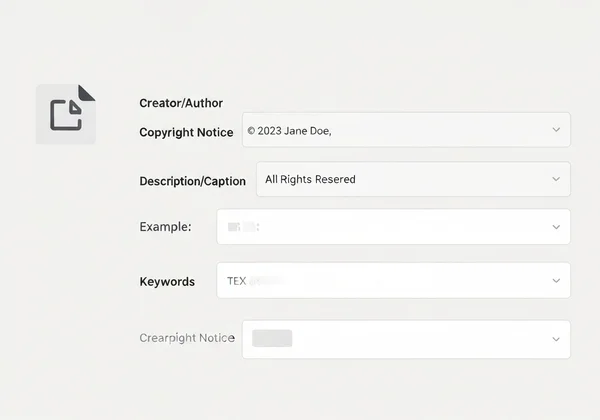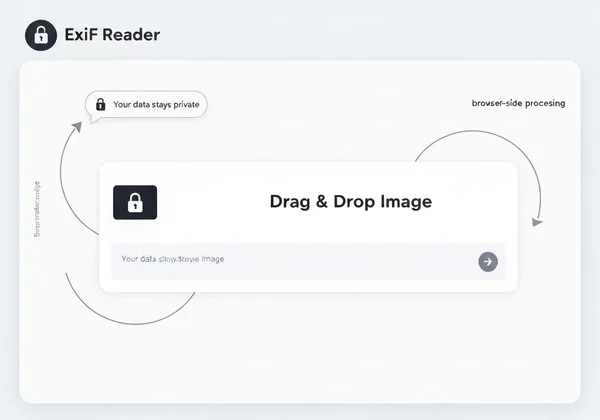IPTC vs. XMP: Understand Image Metadata with Our Exif Reader Tool
Beyond the shutter speed, aperture, and ISO settings found in EXIF data, your images hold a wealth of professional information within IPTC and XMP metadata. For photographers, content creators, and digital asset managers, understanding these standards is the key to protecting copyright, streamlining workflows, and managing vast libraries of content. But what is EXIF data, and how do these other standards build upon it? An exif reader can help you uncover this data. This guide will demystify IPTC and XMP, highlight their unique strengths, and show you how to unlock this powerful information instantly. You can view image metadata with our free exif reader tool right now.

Unpacking IPTC Data: The Standard for Content and Copyright
When you need to attach descriptive and administrative information to your photos, IPTC data is the industry standard. Developed by the International Press Telecommunications Council, it was originally designed for photojournalists to transmit captions and credit information along with their images in a fast-paced news environment. Today, its role has expanded, becoming an essential tool for any creator who needs to manage and protect their work.
What is IPTC Data and Why Photographers Need It?
At its core, IPTC is a set of metadata fields that answers the crucial questions about an image: Who created it? What does it depict? Where and when was it taken? And, most importantly, who owns the rights to it? For photographers, embedding this copyright information directly into the image file is a critical first step in protecting their intellectual property. When an image is shared or licensed, the IPTC data travels with it, acting as a digital name tag that asserts ownership and provides contact details. This is indispensable for managing stock photography portfolios, licensing images to clients, and ensuring proper credit is given wherever the photo appears.
Key IPTC Fields: Copyright, Description & Keywords for Creators
To make your images discoverable and manageable, understanding key IPTC fields is essential for effective digital asset management. Some of the most critical fields for creators include:
- Creator/Author: Your name or your company's name. This is the foundation of attribution.
- Copyright Notice: The classic "© [Year] [Creator Name], All Rights Reserved" statement. This field makes your ownership claim explicit.
- Description/Caption: A rich, detailed text describing the content of the image. This is vital for news agencies, stock photo sites, and archival purposes.
- Keywords: Tags that describe the key subjects, themes, and concepts in the photo. Using relevant keywords makes your images searchable in databases like Adobe Bridge, Photo Mechanic, or online asset management systems.
- Contact Information: Your email, website, and phone number, allowing potential clients to easily reach you for licensing inquiries.
By diligently filling out these fields, you transform a simple image file into a self-contained, professional asset. You can easily check your photos for metadata to see if this data is already present.

Exploring XMP Metadata: Enhance Your Image Metadata Viewer Workflow
While IPTC provides a rigid and standardized structure, what is XMP metadata offers a modern, flexible, and extensible alternative. Developed by Adobe in 2001, the Extensible Metadata Platform (XMP) was created to embed metadata in a way that could be easily read and edited by different applications across a complete creative workflow. It’s the secret language that allows programs like Adobe Lightroom, Photoshop, and Bridge to communicate seamlessly.
The Evolution of XMP: A Dynamic Metadata Framework
Unlike the fixed fields of IPTC, XMP is built on XML (Extensible Markup Language). This means it’s not limited to a predefined set of tags. Developers and organizations can create their own custom metadata "schemas" to store virtually any kind of information. Think of it as a universal container for data. This is why Adobe XMP is so powerful; it can store not only standard IPTC information but also a vast range of other details, from camera raw settings to complex editing histories. This extensibility ensures XMP can adapt to future technologies and new workflow demands.
Common XMP Applications: Editing History, Ratings & Custom Data
For creators engaged in a digital creator workflow, XMP is the engine running behind the scenes. Its practical applications are numerous and incredibly valuable:
- Non-Destructive Edits: When you adjust exposure or color in Adobe Lightroom, those changes are stored as XMP data, either in a "sidecar"
.xmpfile or embedded directly. This preserves your original image file. - Ratings and Labels: The star ratings, color labels, and pick/reject flags you apply to sort your photos are all XMP data. This helps you quickly cull and organize thousands of images.
- Editing History: XMP can store a log of the adjustments and filters applied to an image, providing a valuable record of the creative process.
- Custom Schemas: A large photography studio could create a custom XMP schema to track internal project codes, client names, and approval statuses directly within the image file.
XMP is the framework that holds your entire post-production process together, making it organized, repeatable, and portable.

IPTC vs. XMP: Understanding the Key Differences and Synergies
While they serve related purposes, IPTC and XMP are not interchangeable. Understanding their differences is key to using them effectively. The best way to see how they are implemented in your own images is to use a free online exif reader tool to inspect the metadata.
Comparing Structure and Purpose: A Side-by-Side Overview
Here’s a simple breakdown of their core differences:
- Structure: IPTC has a fixed, standardized structure defined by the IPTC organization. XMP is extensible and flexible, based on XML, allowing for custom data fields.
- Origin & Purpose: IPTC was born from the news industry for descriptive and rights information. XMP was created by Adobe for workflow integration and process-related data.
- Compatibility: IPTC is an older, widely recognized standard. XMP is the modern standard used by most current editing software and is designed to encompass IPTC information.
Think of it this way: IPTC is like the printed label on a file folder, containing essential, permanent information. XMP is like a collection of sticky notes inside the folder, detailing every time it was opened, what was changed, and who worked on it.
How IPTC and XMP Work Together for Comprehensive Image Information
The good news is that you don’t have to choose between them. Modern metadata standards ensure they work in harmony. When you enter caption or copyright information into a program like Adobe Lightroom, it saves that data in the appropriate IPTC fields. Simultaneously, it maps that same information into the XMP structure. This is called "IPTC-in-XMP."
This dual approach provides the best of both worlds: the universal compatibility of the classic IPTC standard and the flexibility and richness of XMP. Together, they create a complete, robust record of your image's descriptive, administrative, and technical history, which is essential for establishing content credentials and authenticity.
Instantly View IPTC & XMP Data with Our Online Exif Reader
Now that you understand the importance of this hidden data, how can you see what’s inside your own photos? You don't need to install bulky software or worry about your privacy. With our powerful online exif reader tool, you can get a complete metadata report in seconds.
A Step-by-Step Guide to Using Our Exif Reader to View Creator Data
Viewing your image’s full metadata profile is incredibly simple. All you have to do is analyze your image with our Exif Reader. Here's how it works:
- Visit the Homepage: Visit the homepage of our online exif data reader.
- Select Your Image: Drag and drop your image file (JPEG, TIFF, HEIC, etc.) directly onto the page, or click to browse and select a file from your computer.
- View Instantly: The tool will immediately process the file—right in your browser—and display a cleanly organized report. You can scroll through to see everything from basic EXIF to detailed IPTC and XMP sections, revealing all the photo details.
Your Data Stays Private: Our Exif Reader's Browser-Side Advantage
As creators, your images are your assets. The last thing you want is to upload them to an unknown server. This is our core commitment to you. Our image metadata viewer operates entirely within your web browser. Your image file is never uploaded and never leaves your computer. This browser-side processing guarantees absolute privacy and security, giving you the peace of mind to check any photo, anytime. Try it now with our secure exif viewer.

Master Your Metadata, Empower Your Workflow
Metadata isn't just data—it's the bedrock of professional image management. By leveraging the descriptive power of IPTC and the flexible framework of XMP, you gain unparalleled control over your creative assets. Equip yourself with this knowledge, and with tools like our online exif reader, you'll ensure your photos are not only visually striking but also professionally managed and protected.
Are you ready to unveil the secrets hidden in your own photos? Go to our free exif reader to instantly and safely explore the rich IPTC and XMP data embedded in your images.
Frequently Asked Questions About IPTC & XMP Metadata
What is the main difference between IPTC and XMP metadata?
The main difference lies in structure and purpose. IPTC is a standardized, fixed set of fields primarily for descriptive and copyright information (the "what" and "who"). XMP is a flexible, extensible framework designed by Adobe to store a wide range of data, including editing history, ratings, and custom workflow information (the "how").
Can your exif reader help me view IPTC and XMP data in my photos?
Yes, absolutely. Our online exif reader is designed to provide a comprehensive view of all major metadata standards. When you analyze a photo, our tool parses and clearly displays all available IPTC and XMP fields, alongside the standard EXIF data, giving you a complete picture.
Why is it important for photographers to understand IPTC and XMP?
Understanding this data is crucial for professionalism and efficiency. IPTC helps photographers protect their copyright and makes their work discoverable in stock libraries and archives. XMP streamlines their post-production workflow by tracking edits, ratings, and keywords, saving significant time and ensuring consistency.
Does sharing images online (like on social media) remove IPTC or XMP metadata?
Often, yes. Most social media platforms like Instagram and Facebook strip the majority of metadata, including IPTC and XMP, from uploaded images to save space and protect user privacy. This is why checking your photos with an exif viewer before sharing is a good practice if you're concerned about embedded location data.
How can IPTC and XMP data help protect my photo copyright?
Embedding your name in the "Creator" field and a formal notice in the "Copyright" field of the IPTC/XMP data acts as a public claim of ownership. While not a substitute for official copyright registration, it serves as a strong deterrent against unauthorized use and makes it easy for honest users to identify you as the rights holder and seek permission to use your work.